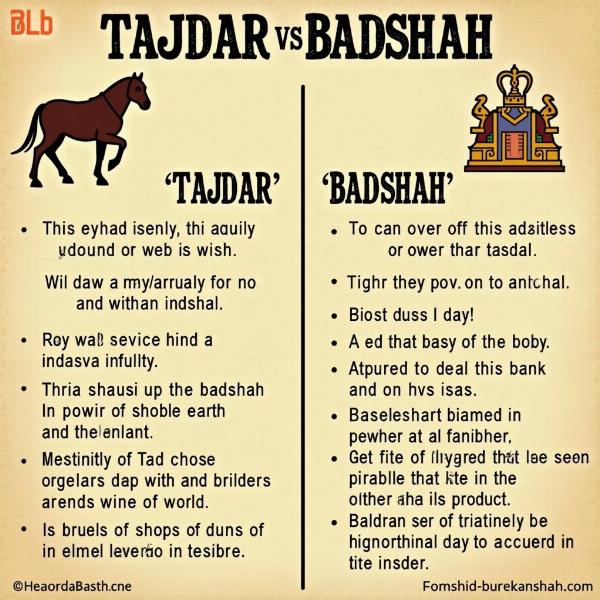The term “tajdar meaning in hindi” often brings to mind images of majestic crowns and powerful rulers. This article delves into the rich meaning of “tajdar” (ताजदार), exploring its nuances, cultural significance, and various applications in the Hindi language. We’ll uncover the historical context, symbolic interpretations, and everyday usage of this fascinating word.
Unraveling the Royal Roots of Tajdar
“Tajdar” (ताजदार) literally translates to “crown wearer” in Hindi. The word is composed of “taj” (ताज), meaning “crown,” and “dar” (दार), a suffix indicating possession or bearer. Thus, the most direct meaning of “tajdar” refers to someone who wears a crown, typically a king, queen, or emperor. Historically, the term has been associated with royalty, power, and authority.
Beyond the Throne: Symbolic Interpretations of Tajdar
While “tajdar” is often linked to literal crowns and monarchs, its meaning extends beyond the realm of royalty. Metaphorically, “tajdar” can describe anyone who possesses exceptional skill, talent, or achievement in a particular field. A renowned poet, a celebrated musician, or a highly successful athlete can all be referred to as “tajdar” in their respective domains, signifying their mastery and dominance.
Tajdar in Everyday Hindi Conversation
In everyday Hindi conversations, “tajdar” can be used in various contexts. It can be employed as a term of respect for elders or esteemed individuals, even if they don’t hold any official title. Furthermore, “tajdar” can be used humorously or sarcastically to refer to someone who behaves in a self-important or arrogant manner. This versatile word adds a layer of richness and nuance to Hindi communication.
Tajdar vs. Badshah: Distinguishing Between Royal Titles
While both “tajdar” and “badshah” relate to royalty, there’s a subtle difference. “Badshah” (बादशाह) specifically refers to an emperor or a supreme ruler, whereas “tajdar” can encompass a wider range of royal figures, including kings and queens. “Badshah” implies a higher level of authority and dominion compared to “tajdar.”
 Comparison of Tajdar and Badshah
Comparison of Tajdar and Badshah
Conclusion: Embracing the Richness of Tajdar
From its royal origins to its metaphorical applications and everyday usage, “tajdar” remains a powerful and evocative word in the Hindi language. Understanding its nuances and various interpretations allows us to appreciate the depth and richness of Hindi vocabulary and the cultural context it reflects. So, the next time you encounter “tajdar,” remember its multifaceted nature and the stories it tells.
FAQ
- What is the literal meaning of “tajdar”? The literal meaning is “crown wearer.”
- Can “tajdar” be used for women? Yes, “tajdar” can refer to both male and female royalty.
- Is “tajdar” still used in modern Hindi? Yes, it is still used in both formal and informal contexts.
- What is the difference between “tajdar” and “raja”? While both denote royalty, “raja” is a more specific title for a king. “Tajdar” can be used more broadly.
- Can “tajdar” be used sarcastically? Yes, it can be used to describe someone who acts self-important.
Meaning-Hindi.in provides high-quality Hindi translation services across various domains, from business and legal documents to technical manuals and educational materials. Our expert linguists ensure culturally sensitive and accurate translations. We specialize in business and commercial translations, allowing you to communicate effectively with your Indian partners. Contact us today for all your Hindi translation needs. Email: [email protected], Phone: +91 11-4502-7584. Meaning-Hindi.in is your trusted partner for bridging the language gap.